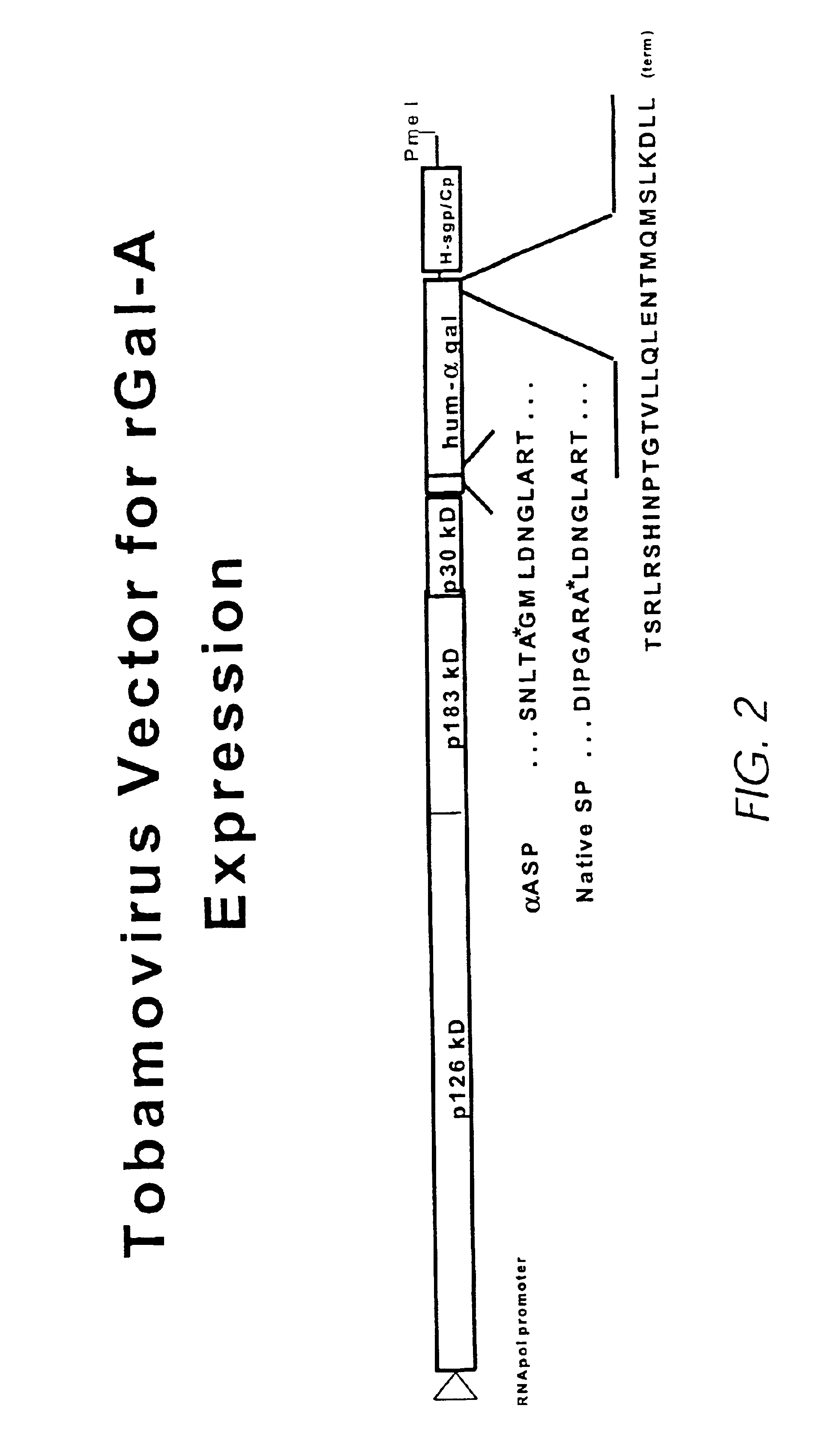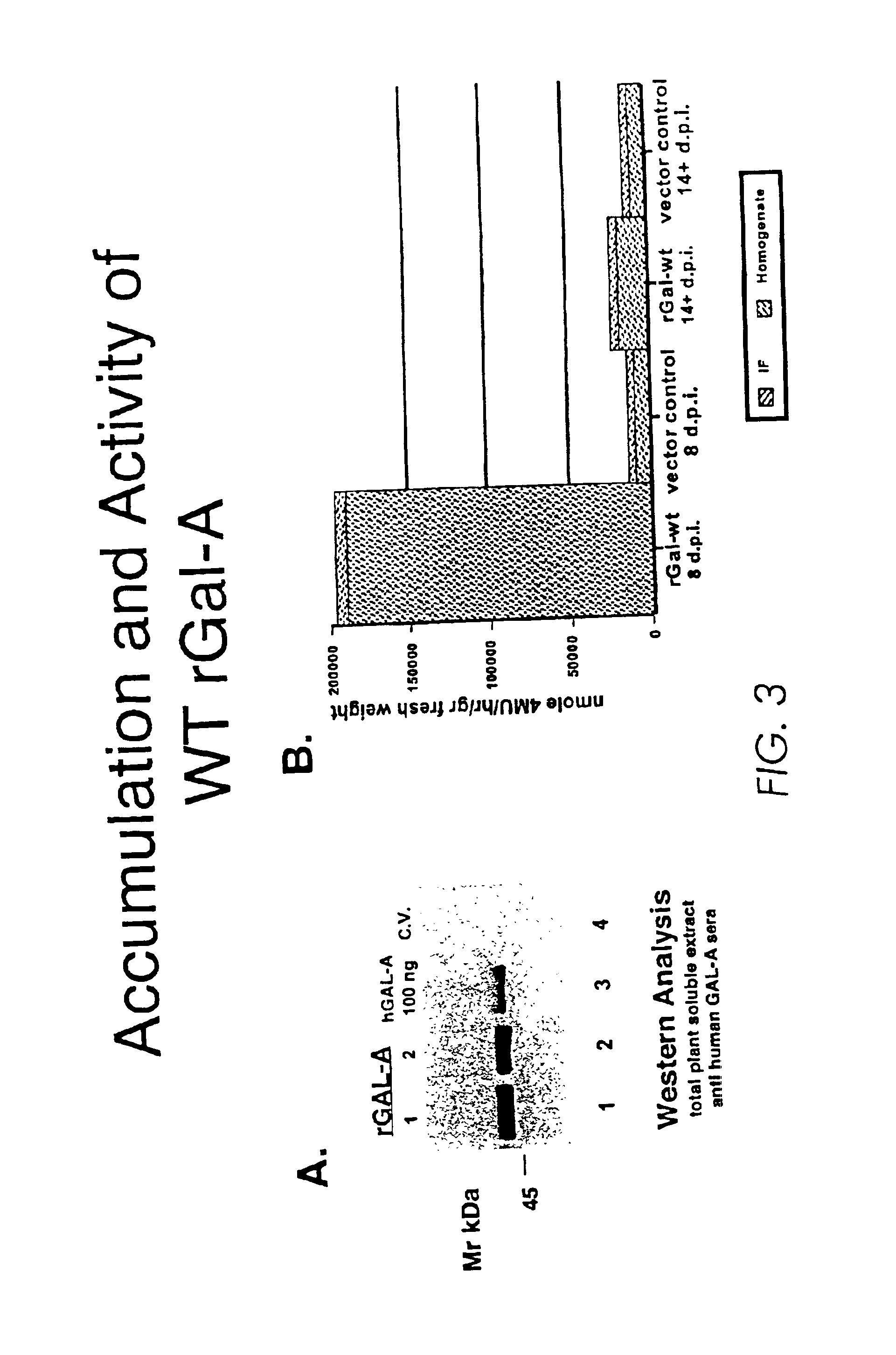Production of lysosomal enzymes in plants by transient expression
a technology of lysosomal enzymes and plants, applied in the field of therapeutic peptides, can solve the problems of inability to conduct further investigation, inability to commercially manufacture lysosomal enzyme replacement enzymes, and inability to meet the needs of patients, and achieve high specific activity
- Summary
- Abstract
- Description
- Claims
- Application Information
AI Technical Summary
Benefits of technology
Problems solved by technology
Method used
Image
Examples
example 1
[0115]We have established that a recombinant human lysosomal enzyme (rGCB) synthesized in transgenic tobacco has comparable activity to the same enzyme isolated from other native and recombinant sources. We also investigated the feasibility and economic advantages of purifying large quantities of active rGCB from plants. We designed and fabricated laboratory equipment that enabled us to optimize the key initial steps of a purification process in the laboratory using kilogram quantities of biomass from our greenhouses. We standardized a series of assays for secretory and intracellular marker enzymes in addition to rGCB assays that allowed us to monitor both lab and field expression as well as the purification process. Leaf tissue was infiltrated with a suitable extraction buffer while submerged in a large vacuum chamber, allowing the solution to reach the leaf intercellular fluid containing rGCB. The IF fraction was recovered by centrifugation in a custom collection chamber and “bask...
example 2
Extraction of Glucocerebrosidase Protein
[0211]Glucocerebrosidase (GCB), either derived from human placental tissue or a recombinant form from Chinese hamster ovary cells (CHO), is presently used in an effective but costly treatment of the heritable metabolic storage disorder known as Gaucher disease. We combined a dual promoter from Cauliflower Mosaic Virus (35S), a translational enhancer from Tobacco Etch Virus and a polyadenylation region from the nopaline synthetase gene of Agrobacterium tumefaciens with the native human GCB cDNA to create plasmid pBSG638. These expression elements are widely used to provide the highest possible constitutive expression of nuclear encoded genes in plants. The CaMV promoter is further inducible by stress or wound treatment.
[0212]Using a standard Agrobacterium-mediated transformation method, we regenerated 93 independent kanamycin-resistant transformants from leaf discs of four different tobacco cultivars (the TO generation). In Western blots of tot...
example 3
Laboratory Pilot Scale Purification of Glucocerebrosidase from the Intercellular Fluid of Tobacco
[0215]MD609 leaf tissue (1-2 kilograms) of transgenic tobacco expressing the lysosomal enzyme glucocerebrosidase was harvested, the mid vein removed and the tissue weighed. Tissue was submerged with 2-4 volumes of buffer (0.1 M KPO4 buffer, pH 6.0, 5 mM EDTA, 0.5% taurocholic acid, 10 mM β-mercaptoethanol) in an infiltration vessel that accommodates several kilograms of leaf tissue at one time. A perforated metal plate was placed on top of tissue to weigh down the tissue. A vacuum of 25-27 in. Hg was applied for 1-2 minutes×3. The vacuum was released between subsequent applications. Tissue was rotated and the vacuum reapplied to achieve complete infiltration. Multiple applications of the vacuum without isolating the intercellular fluid constitutes a single infiltration procedure. An indication of complete infiltration is a distinct darkening in color of the underside of the leaf tissue. ...
PUM
| Property | Measurement | Unit |
|---|---|---|
| molecular weight | aaaaa | aaaaa |
| molecular weight | aaaaa | aaaaa |
| molecular weight | aaaaa | aaaaa |
Abstract
Description
Claims
Application Information
 Login to View More
Login to View More - R&D
- Intellectual Property
- Life Sciences
- Materials
- Tech Scout
- Unparalleled Data Quality
- Higher Quality Content
- 60% Fewer Hallucinations
Browse by: Latest US Patents, China's latest patents, Technical Efficacy Thesaurus, Application Domain, Technology Topic, Popular Technical Reports.
© 2025 PatSnap. All rights reserved.Legal|Privacy policy|Modern Slavery Act Transparency Statement|Sitemap|About US| Contact US: help@patsnap.com



